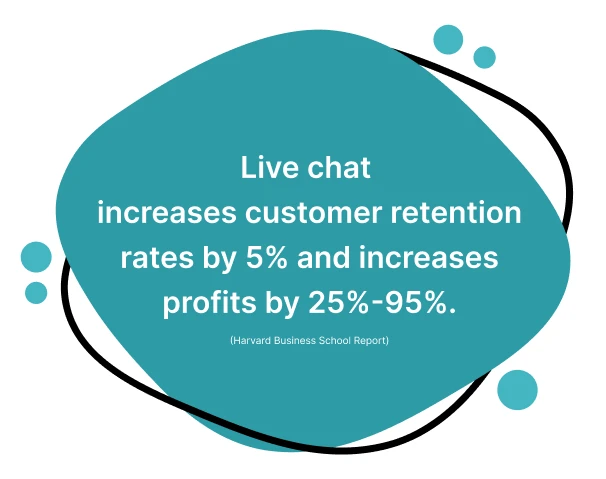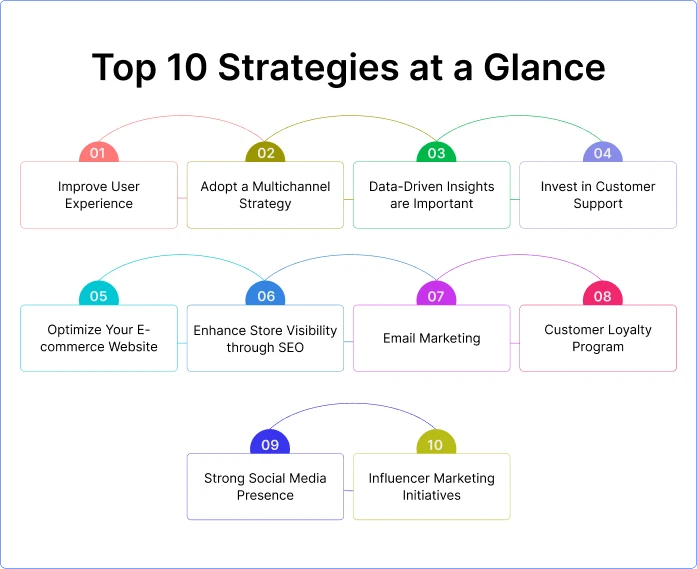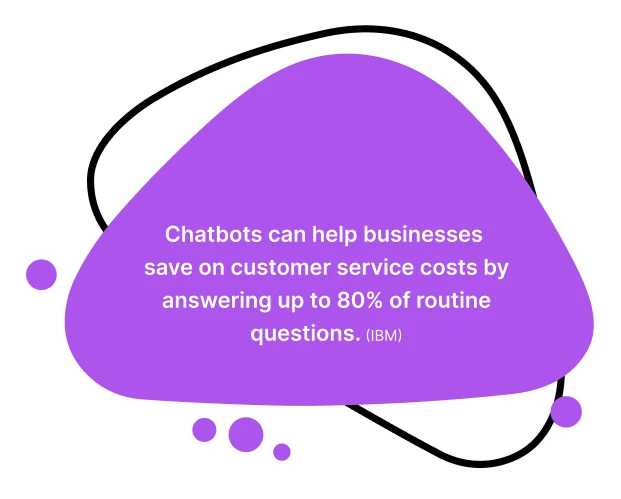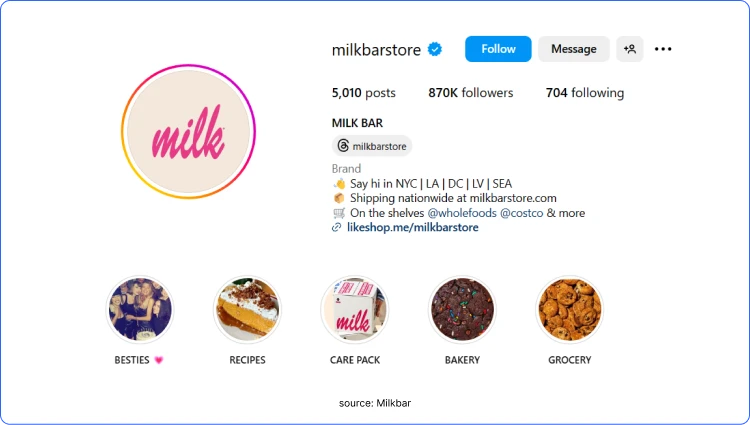Developing and expanding an eCommerce business is not an easy task. The competition is huge with so many big giants already ruling in this industry. On the other hand, customers have become more selective when choosing brands for doing business.
In such a scenario to stay ahead in the long race, developing an effective eCommerce growth strategy is important, and it should be aligned with customer preferences and their buying behavior. Your eCommerce business strategy must combine the latest technologies such as AI, innovation, adaptability, and practical planning.
Sound complicated? Don’t worry. If you want to know how to expand the online business then you are at the right place. Here today I will discuss, what an eCommerce growth strategy is, why it’s important, and the best 10 ways to get it right.
So, keep reading this space to know more!
What is an eCommerce Growth Strategy?
An eCommerce business strategy is a set of comprehensive strategies and activities that outlines how an eCommerce business can achieve its goals: selling products online, eventually growing its business, and staying ahead of others in the digital marketplace. This strategy covers different aspects of the eCommerce business operations including customer support, sales, marketing, technology, logistics, etc.
The goal of an eCommerce business strategy is to maximize revenue, profitability, and market share while delivering value to customers and maintaining operational efficiency. It involves analyzing market trends, understanding customer needs and preferences, identifying growth opportunities, and developing actionable plans to capitalize on those opportunities effectively.
Why You Need to Build an eCommerce Business Growth Strategy
Having a road map is always helpful for making your business successful. Here is not an exception. Having a clear growth strategy for your eCommerce business helps you to have a clear vision of how to proceed further. Its benefits include:
-
Company Stability
An eCommerce business development strategy works as a blueprint for new product launches, upgrades, campaigns or even targeting a new customer segment. You can get new customers as well as turn one-time clients into loyal ones.
Your eCommerce strategy covers everything from marketing and customer service to sales. It gives you an idea about website traffic or even monthly revenue. You get the info about why website visitors are dropping and how to get back on track. In short, it helps you to have a stable company with happy and satisfied team members.
-
Being Better than Others
As a part of the eCommerce growth strategy, you need to do competitor research to understand what extra they are offering and how you can improve your product offerings to stay ahead of the competition. With research, you can create your unique value proposition and offer your customers what exactly they want.
-
Cost Efficiency
Your business growth strategy helps you to save costs on different segments. It enables you to optimize tech stack, inventory management, supply chain procedures, costings, and productivity to serve customers in a better way.
-
Understanding Your Target Audience
Improving your online store can be tough if you’re not sure what’s going well and what’s not. But with eCommerce growth tactics, you can see data about your target audience, their buying behavior, and preferences. This info helps you figure out what needs fixing so you can make your online store better.
-
Increased Sales Conversions
In an online business, you aim to make money. A well-thought-out structured growth plan helps to pinpoint inefficiencies and provides exceptional online shopping experience and top-notch customer service that increases sales conversions.
-
Customer Retention
Studies indicate that it costs more money to get a new customer than to keep one you already have. Having an eCommerce plan helps turn one-time buyers into regular customers who pick your brand among other options.
-
Getting New Customers
You can properly strategize in such a way that new customers land on your eCommerce website and purchase from you. Just like retaining old customers, it helps to gain new ones also.
Things to Keep in Mind Before Building Your eCommerce Growth Strategy
Building a successful eCommerce growth strategy requires careful planning and consideration of various factors. Here are some key things to keep in mind before you start creating one.
-
Reframe Your Core Values
A mission statement is like a company’s heart—it shows what it believes in, why it exists, and what it promises to do. Making one can steer your business choices in the right direction and can also help tell people about your business in a good way. People prefer to buy from companies they believe in, even if it costs a bit more.
-
Future Business Objectives
Decide first what is the objective of your eCommerce brand. Understanding what you want to achieve in one, ten, or even 20 years will help you to develop the right roadmap for your business.
Instead of focusing on short-term goals, look broad. Otherwise, you may miss out on big investment plans that can be beneficial for you in the long run.
-
Preferred Clientele and Market Segment
If you don’t know who are your target customers and have not segmented the target market, you are in trouble. Because they are the ones who are going to buy your products and for them only you have developed your product offerings.
Pause before jumping into creating a growth plan. Understand the needs, pain points, preferences, and buying patterns of your target customers. Once you get all that data, develop a solid eCommerce business strategy based on that.
-
Client Requirements
Once you know who buys from you, you can go even further to figure out what they need and like. There are many tools and techniques to do this such as by looking at numbers on Google Analytics or just by asking them questions in a survey. This will help you understand your customers better, so you can make smarter decisions for your online store.
-
Customer Touchpoints
You need to visualize the buyer’s journey from beginning to end. This will help you to make changes if required to streamline the whole process and make it a smooth journey for your customers.
One way to do it is by creating a flow chart detailing the marketing funnel where all the necessary steps are added that a customer needs to take in the journey- starting from knowing about your brand to becoming your repeated customer. It has to be specific and detailed to understand all major interactions that will happen between your brand and the buyers.
-
Omnichannel Approach
Customers have their preferred mode of communication. It can be email, phone, live chat, chatbot, or maybe social media channels. To serve them better you have to be available on each of these platforms and manage all the interactions efficiently. You also need to be careful that the messaging is consistent everywhere otherwise it may create confusion.
So, taking the omnichannel approach is important if you want your eCommerce brand to do well in the competition.
Top 10 Strategies for eCommerce Success
It’s been nearly 4 years since the onset of COVID-19. Most of the companies have successfully partially shifted to online for catering to the high customer demands. To make this transition sustainable, you need to manage many important aspects carefully like the proper technology, infrastructure, right team recruitment, shipping, and billing.
To make things perfect, and stand strong in the huge competition you need to develop a strong eCommerce growth strategy. Here are the 10 important tactics for your kind consideration. These techniques will help you boost interaction, and improve conversion rates, and business growth.
1. Improve User Experience
The shopping experience has to be seamless and delightful. Customers should feel good while browsing your online store. So choose a good eCommerce platform, and make your website easy to access, user-friendly, and visually appealing. Also remember to optimize it for both desktop, tab, and mobile.
How can you do it? Here are some tips for you!
- Create a mobile-friendly website.
- Make sure the website loads fast.
- Upload high-quality videos and images.
- Provide accurate product descriptions.
- Offer different payment modes.
- The checkout process has to be easy and simple.
- Conduct A/B testing on a regular basis to identify areas for improvement
- Display user-generated reviews and ratings prominently on product pages to build trust and credibility.
- Offer personalized product recommendations through data analytics.
2. Adopt a Multichannel Strategy
The multichannel approach is super important nowadays. Besides your website, think about selling on social media and other online marketplaces. This helps you reach more people. When you sell in these different places, make sure your brand looks the same everywhere. This helps you to gain customer trust.
Here’s how to do it:
- Use different marketing channels to tell your target audience about the product offerings.
- Keep an eye on the sales for each of those platforms.
- Utilize data analytics to gain insights into customer behavior, preferences, and trends across different channels.
- Implement an efficient inventory management system to prevent overselling and maintain stock availability across all channels.
- Tailor your marketing campaigns for each channel to maximize engagement and conversions.
3. Data-Driven Insights are Important
Yes, you can say data is the most important thing to consider in your eCommerce growth tactics. It gives you detailed insights into customer demographics, buying behavior, and preferences so that you can personalize your offerings. Not only that, detailed analytics helps you to tweak your sales, and marketing strategies, and optimize inventory management for better results.
Pro Tips:
- Collect detailed reports from your website, different campaigns, surveys, and client interactions.
- Opt for the best reporting tools to get detailed reports.
- Go through the customer data for audience segmentation based on their geographic locations, buying behavior, and preferences.
- Utilize purchase history and browsing behavior data to provide personalized product recommendations.
- Employ dynamic pricing strategies based on real-time market data.
- Utilize website and user behavior analytics to identify and address bottlenecks in the conversion funnel.
4. Invest in Customer Support
Customers need instant assistance with their queries. Providing exceptional customer support has to be in your growth strategy if you want your online business to go long. Apart from traditional phone and email support, offer real-time assistance through live chat and AI chatbot.
Live chat tools for your eCommerce business offer instant assistance to your customers on the web, mobile, and other social media platforms. It lets your agents monitor customers in real time and proactively engage with them to offer assistance before they ask for it.
AI-powered eCommerce chatbots are great options when you want to automate different business operations including customer service. It can handle multiple customer interactions simultaneously 24/7 even after your business hours.
How to choose the best live chat solution for your business? Here’s one checklist for you!
- Opt for a platform that is intuitive and user-friendly for both your team members and customers.
- The software should enable you to customize the chat widget to match the look and feel of your website.
- Consider a live chat solution that supports multiple channels.
- Ensure the live chat software is mobile-friendly and offers apps or responsive design for agents and customers who prefer to chat on mobile devices.
- Ensure that it offers all the advanced features required.
- The chat solution should offer robust analytics and reporting tools to track chat performance, monitor agent productivity, and gather insights into customer behavior and preferences.
5. Optimize Your eCcommerce Website
To increase sales conversions, you need to optimize your eCommerce website. It helps to bring in more and more visitors and gives you a great opportunity to turn them into paying customers. Suppose you are getting 50,000 visitors to your website from Facebook, but the website takes too much time to load. In that case, you are going to lose many of them. Such kind of bad experience will make you lose lots of prospects no matter how much you invest in other marketing and sales campaigns.
How to optimize the website? Here are some tips for you!
- Develop a mobile-friendly website for a seamless browsing and purchasing experience.
- Offer various payment options.
- Use clear and high-quality pictures and videos to show off your products from various angles.
- Write interesting and detailed descriptions for your products.
- Offer an easy checkout process.
- Display customer reviews, ratings, and testimonials prominently on your product pages to build trust and credibility.
6. Enhance Store Visibility through SEO
Search Engine Optimization (SEO) helps you to get a higher rank in the search results when users type keywords (different phrases that they search to get details) related to your business. Getting a higher rank there gives you more and more visitors to your online store.
Let me give you one example here. Suppose you have an eCommerce website for designer clothes and accessories. One special segment in your collection is vintage hats and you want more and more people coming to that specific page.
So, with SEO you need to optimize the page using the keyword ‘vintage hats’ so that when people type with that keyword, your page will come in the top results and customers visit that page to know more about it and finally buy that product.
I have some SEO tips for you!
- Conduct thorough SEO research to find keywords that are relevant to your business or product offerings.
- The selected keywords should not be highly competitive.
- Your keywords should have a higher number of search volumes per
- Aren’t highly competitive (i.e., low keyword difficulty)
- The keywords should have a monthly high number of search volumes.
- Develop high-quality, engaging content such as blog posts, product guides, and tutorials that incorporate targeted keywords.
- Use descriptive filenames and alt tags for your product images to improve their visibility in image search results.
- Ensure that your eCommerce website is optimized for mobile devices, as Google prioritizes mobile-friendly websites in search results.
7. Email Marketing
We all get thousands of emails every day so do your target customers. But do we open all of them? Not exactly. You need to make them open yours. How? Through attractive subject lines and email content. So, write catchy headlines, and add high-quality pictures, useful content, and social proofs in a beautiful template. Also, you need to have an email sequence that should be sent to customers at various stages of their buying journey to get the maximum results.
Pro Tips:
- Organize your email list into groups based on factors like geographic locations, purchase history, browsing behavior, or engagements.
- Use personalization techniques to make your email content more relevant and engaging to individual subscribers.
- Set up automated email workflows.
- Launch email campaigns to promote sales, discounts, special offers, and new product launches.
- Design visually appealing and mobile-responsive email templates.
8. Customer Loyalty Program
Arranging a loyalty program is one of the best marketing strategies for eCommerce businesses. It always helps you to retain more and more customers. It’s a great idea to reward your customers for their repeat purchases. it makes them feel valued and motivated to do more business with you. The rewards can be anything from bonuses, and free samples to exclusive deals.
An excellent example is makeup brand Sephora’s ‘Beauty Pass’. They have a loyalty system where customers get better rewards as they spend more money.
Some loyalty program ideas:
- Points-based system
- Surprise on special occasions
- VIP membership
- Personalized offers
- Exclusive events invites
- Referral program
- Birthday rewards
9. Strong Social Media Presence
Nearly 82% of people use social media platforms for online shopping so always be available where your customers are. Your social media presence will help you to reach more prospects, increase brand awareness, and boost sales conversions. Apart from that, the more you interact with them on diverse platforms the more you will get to know about their likes, dislikes, and buying behavior. It’s a great way to develop a long-lasting relationship with them. It helps you to retain your existing customers as well as attract new ones.
Many brands use social media for brand awareness and sales. Milk Bar is one such example. Before COVID-19, Milk Bar, a bakery chain in the U.S, made most of its money (75%) from its stores. They also got 25% from online sales. But when COVID-19 came, they could lose most of their money. To prevent this, its founder Christina Tosi, started using Instagram to advertise.
Now, Milk Bar’s Instagram has 870K followers. They also bring many visitors to their online store through social media.
10. Influencer Marketing Initiatives
Well, influencer marketing is a trending concept nowadays. What is that? Individuals who have a significant following and influence on social media platforms promote your brand. These people, known as influencers, promote your products or services to their audience, leveraging their credibility and reach to drive engagement, traffic, and sales for your brand. Influencer marketing often involves partnerships between brands and influencers, where the influencer creates content featuring the brand’s products or services and shares it with their followers.
Teaming up with such popular people in your field can help your online business grow a lot.
Here’s how to do it:
- Define specific objectives for your influencer marketing campaigns.
- Find influencers who match your customers.
- Work with them to advertise your products.
- Keep an eye on how well your influencer ads are doing.
- Build genuine connections with influencers rather than viewing them solely as a means for promotion.
How REVE Chat Can Help You Out!
To retain customers, increase engagement, and improve sales conversion, you need to offer excellent customer support. This is one of the most important aspects of your eCommerce growth strategy. REVE Chat can be the perfect fit for you here.
REVE Chat serves as your comprehensive hub for all customer service needs. As an omnichannel AI-powered customer service software, it facilitates instant support across your website, mobile apps, and various social media platforms including Facebook, Viber, Instagram, Telegram, and WhatsApp.
This platform allows you to monitor visitors on the web or mobile apps in real time along with insights into their browsing patterns and current page views. Leveraging this data, you can personalize your communication and proactively engage with users, providing instant assistance even before they express a need.
Moreover, REVE Chat offers a smart AI chatbot capable of automating numerous business operations, including customer service. This ensures round-the-clock customer assistance, even beyond regular business hours or during peak support agent activity.
With advanced features like co-browsing, voice/video chat capabilities, a ticketing system, canned responses, and detailed reports, REVE Chat empowers businesses to elevate their customer support experience.
Curious to experience its benefits? Sign Up for a 14-day free trial today and witness firsthand how REVE Chat can revolutionize your customer service approach.









